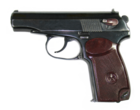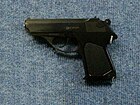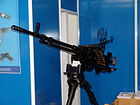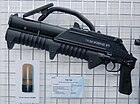| Mongolian Ground Force | |
|---|---|
| Монгол Улсын Зэвсэгт хүчний Хуурай замын цэрэг | |
 The Mongolian Ground Force Emblem | |
| Active | 1921–present |
| Country |
|
| Type | Army |
| Size | 30,000 active personnel[1] |
| Part of |
|
| Nickname(s) | Mongolian General Purpose Force |
| March | The Red Banner March (Тугийн марш/Tugiin Marsh) |
| Engagements |
Mongolian Revolution of 1921 Battle of Baitag Bogd |
| Commanders | |
| Commander | Brigadier general B.Amgalanbaatar |
| Ceremonial chief | Brigadier general B.Ganbaatar |
| Insignia | |
| Banner of the Mongolian Ground force | Mongolian Armed forces - Ground force banner |
The Ground Force of Mongolia (Mongolian: Монгол Улсын Зэвсэгт хүчний Хуурай замын цэрэг, Mongol Ulsyn Zevsegt hüchniy Huurai zamyn tsereg) is the land force of the Armed Forces of the Mongolia, formed from parts of the former Mongolian People's Army in 1992.
History[]

A Mongolian soldier performs during the opening ceremony for exercise Khaan Quest 2013 at the Five Hills Training Area in Mongolia, August 3, 2013.

An honor guard salutes during the welcoming ceremonies for Air Force General Richard B. Myers, who became the first Chairman of the Joint Chiefs of Staff to visit Mongolia, January 13, 2004.
At present Mongolia's armed forces have become more compact and professional since obligatory military service was replaced with the alternative between military and other service. The ground force, a core of the armed forces, are the main force to defend the country by military means. In peacetime, the ground force direct their activities toward ensuring the mobilization readiness of the Mongolian Armed Forces, providing military training for the population, forming personnel resources, and organizing the maintenance, protection and servicing of military equipment and material reserves. Depending on the organizational specifics of military units and organizations, the ground force are divided into combat, on-combat-duty, training, training combat, and stockpile and service units.
As a result of reform processes started in 1997, units of the Mongolian Armed Forces were reorganized into brigade-battalion system . In peacetime, sub-units of brigades have a mixed personnel organization, i.e. of constant combat readiness, training, and under strength. in 2016 former General purpose force is transformed into Ground force of the Armed forces. The 016 Mechanised Brigade has been reported as the oldest formation of the Mongolian army, stationed at Sergelen near Ulaanbaatar.[2]
In 1997 the Mongolian Armed Forces had in service 650 tanks, 120 light armored reconnaissance vehicles, 400 armored infantry fighting vehicles, 300 armored personnel carriers, 300 towed artillery, 130 multiple rocket launchers, 140 mortars, and 200 anti-tank guns.
Mongolia deployed its troops to peacekeeping operations in Iraq and Afghanistan with 1970’s Soviet-bloc weapons, transportation, and equipment. Although Mongolian troops are highly skilled with using these weapons and equipment, they are not interoperable with the rest of the coalition members. Except for the United States-provided Harris Corporation communications equipment, Mongolia had no other equipment which was interoperable.
On January 14–18, 2008, Chief of the General Staff of the MAF Lieutenant General Tsevegsuren Togoo signed an agreement for acquisition of equipment and vehicles from Russia for 120 million US dollars during his official visit to Moscow, Russia.
Peacekeeping missions[]

Afghan National Army (ANA) artillerymen are advised by Mongolian soldiers during a training exercise May 12, 2010. ANA artillery soldiers go through a 3-week course that trains them on command and control of heavy weapons and artillery at Kabul Military Training Center.
Mongolian armed forces are performing peacekeeping missions in South Sudan, Sierra Leone, Ethiopia, Congo, Eritrea, Western Sahara and Afghanistan, and with the United Nations Mission in Liberia. In 2005/2006, Mongolian troops also served as part of the Belgian KFOR contingent in Kosovo. From 2009 Mongolian Armed Forces deploying its largest peace keeping mission to Chad and the government is planning to deploy its first fully self-sufficient UN mission there in mid-2011.
Capability[]

Mongolian Army soldiers salute while the Flag of Mongolia waves at the Transit Center at Manas, where they stayed for several days before moving forward to Afghanistan to support Operation Enduring Freedom.

Members of the Mongolian Expeditionary Task Force 1 stand in formation for Mongolian Army Day at Camp Eggers, Afghanistan. Mongolian Army Day is an annual event that has occurred since 1921.

Members of the Mongolian Armed Forces and Internal Forces practice crowd control techniques as a part of Non-Lethal Weapons Executive Seminar 2010 at 5 Hills Training Facility, Mongolia, June 30, 2010.

Mongolian Powerstar truck in Mongolian military service.
The Ground Forces possess over 470 tanks, 650 Infantry Fighting Vehicles and armored personnel carriers, 500 mobile anti-aircraft weapons, more than 700 artillery and mortar and other military equipment. Most of them are old Soviet Union models designed between the late 1950s to early 1980s. There are a smaller number of newer models designed in post-Soviet Russia.
| Name | Origin | Type | Quantity | Notes |
|---|---|---|---|---|
| Tanks | ||||
| T-54/55 | Main Battle Tank | 370[3] | ||
| T-72[4] | 100[5][6][7] | |||
| Infantry Fighting Vehicles | ||||
| BMP-1 | Infantry Fighting Vehicle | 310[3] | ||
| BMP-2 | Infantry Fighting Vehicle | 100 | ||
| Armored cars | ||||
| BRDM-2 | Amphibious Armoured Scout Car | 120[3] | ||
| Armored Personnel Carriers | ||||
| BTR-60 | Armored Personnel Carrier | 150[3][6] | Most of them are BTR-60PB | |
| BTR-70[4] | 50[8] | |||
| BTR-80[9] | 20[6] | |||
| Multiple Rocket Launchers | ||||
| BM-21 Grad | 122 mm Multiple Rocket Launcher | 130[3] | ||
| Towed artillery | ||||
| D-30 D-44 M-30 M-46 ML-20 |
122 mm Howitzer 85 mm Divisional Gun 122 mm Howitzer 130 mm Towed Field Gun 152 mm Howitzer Gun |
300[3] | ||
| Mortars | ||||
| BM-37 PM-43 M-160 |
82 mm Calibre Mortar 120 mm Calibre Smoothbore Mortar 160 mm Divisional Mortar |
140[3] | ||
| Anti-tank gun | ||||
| SPG-9 D-48 BS-3 T-12 |
73 mm Anti-Tank Gun 85 mm Anti-Tank Gun 100 mm Field Gun 100 mm Anti-Tank Gun |
200[3] | ||
Infantry weapons[]
| Name | Photo | Origin | Cartridge | Notes |
|---|---|---|---|---|
| Semi-automatic pistols | ||||
| TT | 
|
7.62×25mm Tokarev | In storage[10] | |
| PM | 
|
9×18mm Makarov | Standard issue pistol[10] | |
| PSM | 
|
5.45×18mm | Special military use[10] | |
| Submachine guns | ||||
| PP-93 | 
|
9×18mm Makarov | Used by special forces[11][12] | |
| Assault rifles | ||||
| AK | 
|
7.62×39mm | [10] | |
| AKM | 
|
7.62×39mm | Standard issue rifle[10] | |
| AKMS | 
|
7.62×39mm | Used by armored crews and support troops[10] | |
| AK-74 | 
|
5.45×39mm | Used by special forces[10] | |
| AKS-74U | 
|
5.45×39mm | Used by special forces[10] | |
| 9A-91 | 
|
9×39mm | Used by special forces[10] | |
| IMI Galil | 
|
5.56×45mm NATO | Used by special forces[10] | |
| HK G36 | 5.56×45mm NATO | Used by special forces[13] | ||
| M4 carbine | 
|
5.56×45mm NATO | To replace the AK and AKM[10] | |
| Machine guns | ||||
| RPD | 7.62×39mm | [10] | ||
| RPK | 
|
7.62×39mm | [10] | |
| SG-43 | 7.62×54mmR | [10] | ||
| PKM | File:PKM machine gun in storage.jpeg | 7.62×54mmR | [10] | |
| DShK | 
|
12.7×108mm | [10] | |
| NSV | 
|
12.7×108mm | [10] | |
| Semi-automatic rifles | ||||
| SKS | 7.62×39mm | Used by honor guards[14] | ||
| Designated marksman rifles | ||||
| SVD | 
|
7.62×54mmR | [15] | |
| VSK-94 | 
|
9×39mm | Used by special forces[16] | |
| IMI Gala'tz | 
|
7.62×51mm NATO | Used by special forces[16] | |
| Grenade launchers | ||||
| RG-6 | 
|
40 mm caseless grenade | Used by special forces[16] | |
| GM-94 | 
|
43×30mm | Used by special forces[16] | |
| Rocket-propelled grenades | ||||
| RPG-7 | 
|
[10] | ||
References[]
- ↑ The Military Balance 2013
- ↑ "The Mongolian army was T-72 tanks and BTR-70M". Encyclopedia of safety. http://survincity.com/2012/07/the-mongolian-army-was-t-72-tanks-and-btr-70m/. Retrieved June 20, 2016.
- ↑ 3.0 3.1 3.2 3.3 3.4 3.5 3.6 3.7 The Military Balance 2012, p.267.
- ↑ 4.0 4.1 bmpd (September 23, 2012). "Монгольская армия получает танки Т-72 и БТР-70М" (in Russian). livejournal.com. http://bmpd.livejournal.com/338571.html. Retrieved June 20, 2016.
- ↑ http://bmpd.livejournal.com/1694496.html
- ↑ 6.0 6.1 6.2 "SIPRI Arms Transfers Database". Stockholm International Peace Research Institute. https://www.sipri.org/databases/armstransfers. Retrieved June 20, 2016.
- ↑ bmpd (January 23, 2016). "Передача Монголии новой партии российской боевой техники" (in Russian). livejournal.com. http://bmpd.livejournal.com/1694496.html. Retrieved June 20, 2016.
- ↑ http://armstrade.sipri.org/armstrade/page/trade_register.php
- ↑ "БХ-ын сайд тайлангаа тавив" (in Mongolian). News.mn. May 3, 2011. http://www.news.mn/r/89048. Retrieved June 20, 2016.
- ↑ 10.00 10.01 10.02 10.03 10.04 10.05 10.06 10.07 10.08 10.09 10.10 10.11 10.12 10.13 10.14 10.15 10.16 10.17 Jones, Richard D., ed (January 27, 2009). Jane's Infantry Weapons 2009/2010 (35th ed.). Jane's Information Group. ISBN 978-0-7106-2869-5.
- ↑ "084.jpg". http://imageshack.us/photo/my-images/31/mmke.jpg/.
- ↑ Тусгай Хүчин (December 28, 2013). "Mongolian 084th Special Task Battalion". https://www.youtube.com/watch?v=JECK1m-YeWk.
- ↑ "How do modern Mongolians defend their land with so few people?". Quora. 17 September 2017. https://www.quora.com/How-do-modern-Mongolians-defend-their-land-with-so-few-people.
- ↑ "Untitled JPEG". January 2004. http://www.defense.gov/news/Jan2004/200401132f.jpg.
- ↑ "SVD rifles in use in Europe". http://www.dragunov.net/svd_action.html.
- ↑ 16.0 16.1 16.2 16.3 "Unititled JPEG". http://img195.imageshack.us/img195/2406/mongoliansf2.jpg.
This article incorporates public domain material from the CIA World Factbook website https://www.cia.gov/library/publications/the-world-factbook/index.html.
- World aircraft information files Bright Star Publishing London File 332 Sheet 3
External links[]
| Wikimedia Commons has media related to Category:Military of Mongolia. |
- General Staff of the Mongolian Armed Forces (Mongolian)
- Ministry of Defense (Mongolian)
- General Intelligence Agency
- Photo report on the Military Parade for the honor of National Flag of Mongolia, 2011
The original article can be found at Mongolian Ground Force and the edit history here.